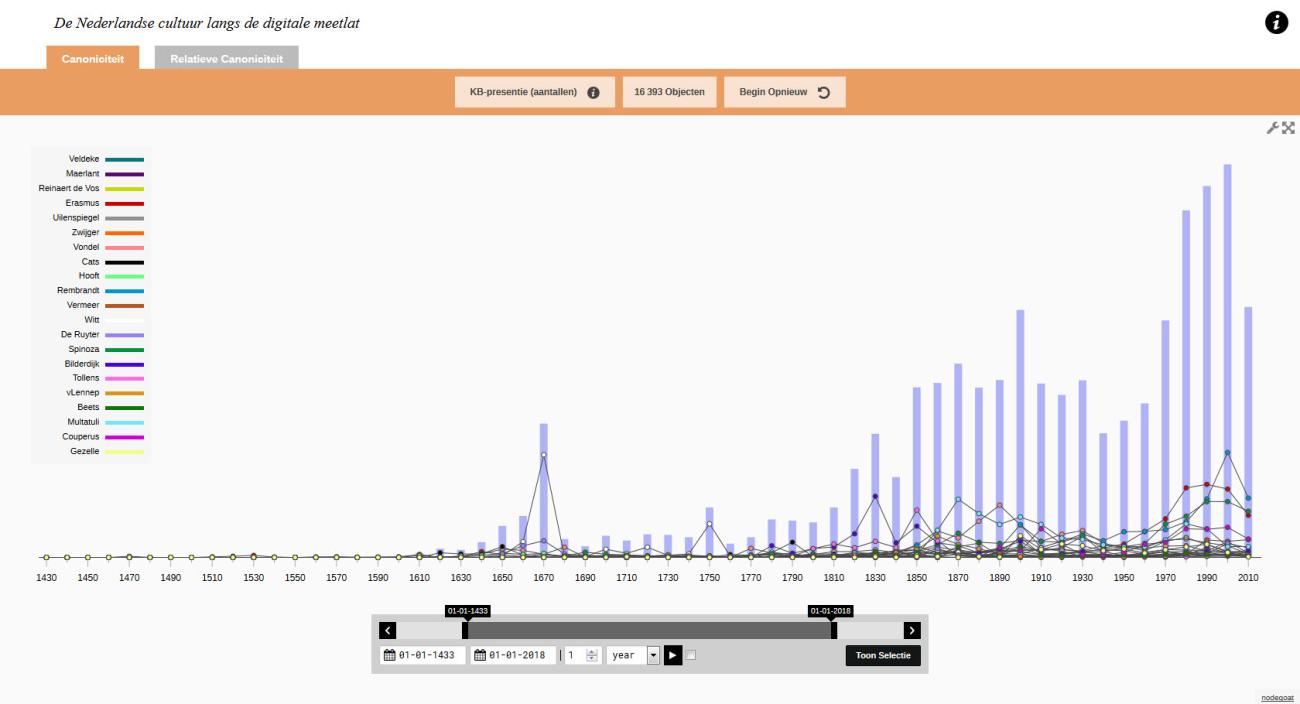Introduction
CanOT (Canonicity Over Time)
Canonicity is an ongoing focus of reflection in literary history. What gives cultural ‘masterpieces’ their prestige? Is it based on their inner merits? If so, are those merits of an ethical, moral nature (the ability to teach us wisdom or virtues, and to edify us), or are the achievements aesthetic: beauty, elegance or emotive power? How do these moral and aesthetic qualities relate to each other? Can you have one without the other? Or is canonicity just a question of luck – a Darwinistic survival in the literary marketplace because of social endorsement related to taste, power relations, fashion, and celebrity?
Challenge
The challenge of this project was to try and approach the question of canonicity without relying on value judgements, moral or aesthetic, or sociological hypotheses. Canonicity can be tracked over time by the capacity of a ‘masterpiece’ to stimulate continuing engagement: generating reprints, translations, adaptations, commemorative events, author’s biographies etc. etc. etc. The KB’s extensive holdings of such spin-off publications can be inventorized and provide a measurement basis. Importantly, they can be dated and thus establish a ‘canonicity curve’, with its ups and downs, over time.
Tipping points
It would be impossible to do so manually. We used digital tools to mine the KB’s catalogue for relevant publications and to analyse their quantity and frequency. The resulting digitally-aided analysis showed interesting ‘tipping points’ in many canonicity curves, significantly around 1800 and 1920. This throws suggestive light on the canonical status and reception history of the Dutch Golden Age.
Visualisations
The interactive web page in the tab Live demo shows the canonicity curves of all relevant publications in the KB related directly or indirectly to 21 selected authors or texts/figures. These are mainly writers, but some canonical figures from the fields of painting or political history have been added to complement the sample. The emphasis was on figures with a long historical trajectory, and within that trajectory on the Dutch Golden Age; the most recent names date from c. 1900. For the older period, when many important works were anonymous, two fictional characters have been added: Reynard the Fox and Thyl Ulenspiegel.
Women in the data
Women – such is the nature of the history of cultural prestige – are badly underrepresented. Only Hadewych is included by name – a medieval poet, but not discovered until the mid-19th century. Her canonicity curve shows that both in absolute and in relative figures she is heavily overshadowed by the male canonicals. That also goes, in an even more extreme form, for other woman authors like Anna Bijns, the Roemer-daughters, Wolff and Deken; Anne Frank is too recent an appearance on the historical timeline to offer a meaningful visualization curve.
When using this tool we request you cite it as follows:
Leerssen, J.Th., Lonij, J., van Bree, P., Kessels, G. (2018) CanOT: Canonicity Over Time. KB Lab: The Hague. http://lab.kb.nl/tool/CanOT
Live demo
Instructions
Please note, the interactive website is in Dutch.
How to use the website
The initial view shows all canonicity curves for all authors in the sample. Filter for one or more by selecting names from the search bar. At any point you can switch view mode between Absolute and Relative Canonicity [see sidebar], or start over by clicking the curve-back icon ("begin opnieuw").
The linear curves indicate the number of the KB holdings connected with a given author. The coloured background bars give (per decade) the total number of library holdings for that decade. The linear curves can be selected/studied singly or in comparative tandem: how the fame of contemporaries rose and fell in their afterlives (e.g. Rembrandt / Vermeer, or Cats/Vondel).
Viewing modes
There are two viewing modes. The default view (tab "Canoniciteit", with blue background bars) shows the publications in absolute numbers. The other tab, "Relatieve Canoniciteit" (pink background bars) gives weighted figures proportional to the total book production in a given decade (a more detailed explanation is given below).
In this ‘relative canonicity’ view, a curve can peak out above its pink background bar, meaning that the author in question is overrepresented in the total productivity of that decade. This it typically the case in the Golden Age, when book production as a whole was relatively low and canonicity was high. The moments when a curve rises above, or dips down below, the background bar, changing between relative over- and under-representation, seems to indicate significant historical transition moments in canonicity.
Examples
These graphs are demonstrated mainly to give a ‘proof of concept’, rather than providing hard and detailed information on an author’s or artist’s reception history. Nor are the samples sufficiently large to provide statistical reliability.
Nonetheless some patterns are suggestive.
- For almost all figures the eighteenth century was a period of relative neglect, with a revival of interest occurring around 1800. At that point the canonicity of Vondel definitively surpasses that of Jacob Cats. The representatives of the Dutch Golden Age enjoyed a very high relative canonicity before 1700 and a high absolute canonicty between 1800 and 1900; for all of them, except Vermeer, a downward trend sets in between 1860 and 1920.
- Jubilee years typically generate a peak in the curve with a small subsequent echo.
- Late twentieth-century canonicity seems above all a continued reverberation of the canonicity peaks of the 17th and 19th century. Could it be that the high relative canonicity of the seventeenth century provided prestige, and the high absolute canonicity of the 19th provided celebrity, to an author’s status nowadays?
- Correcting the mined samples for false hits, we were alerted to a type of ‘zombie canonicity’: the author’s name becomes a brand and is used very frequently, but with little connection to the actual work (e.g. Erasmus giving his name to Rotterdam University, or Boerhaave to a Leiden clinic). This zombie canonicity invites further research, raising questions on the relations between celebrity and canonicity.
